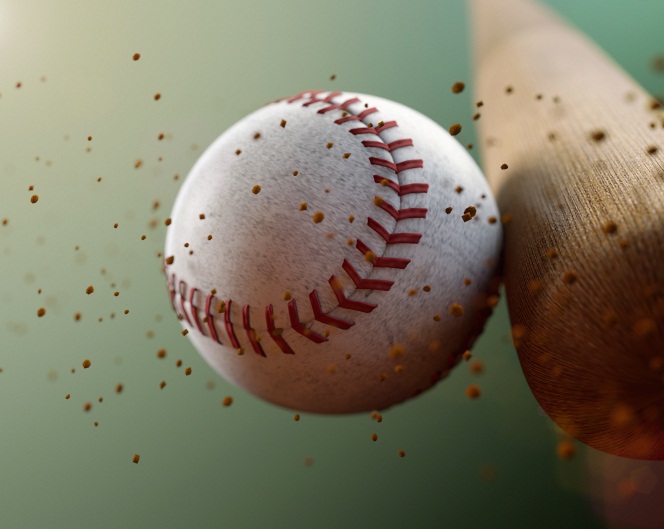Engineering the National Pastime
Baseball traditions – from bases and bats to pitchers and catchers – have changed little over the past 150 years. But in modern times, engineers have contributed immensely to understanding and improving performance, safety, and equipment.
Consider the ball and bat. As Lloyd Smith and James Sherwood note in their delightful April 2010 Mechanical Engineering article, Engineering Our Favorite Pastime, tests have been developed to separately measure the ball’s elasticity and stiffness, thus ensuring that Major League Baseball remains consistent from year to year. [Read a delightful account from the Smithsonian’s Collections Blog of an early attempt to mechanize the stitching of baseballs, which are still hand sewn.]
Evaluating different bats on a common scale – the speed of a hit ball coming off of them – scientists and engineers have been able to raise the performance of metal and composite bats to the level of wood bats. Rose-Hulman Institute of Technology mechanical engineering graduate Keenan Long, a former NCAA Division III All American honorable mention catcher, invented a revolutionary bat that allows the hitter’s hands to rotate independently, increasing the power of the swing.
In campus laboratories nationwide, engineering researchers are developing better equipment and ways to improve player performance. At the University of Michigan, for example, engineers like Noel Perkins, a professor of mechanical engineering, are working on a device to measure swings in an effort to help batters perfect theirs – including developing a wireless inertial measurement unit to measure the three-dimensional motion while you swing the bat. In this short video, What Makes the Perfect Swing in Baseball, he explains the technology, which could be used to improve golf swings and fly-fishing casts as well.
Southern Illinois University researcher Peter Fadde also is helping baseball players improve their swing–using virtual reality. As he notes in this 2017 Frugal Engineering TEDx Talk, hitting a baseball travelling at 98 miles per hour three times in 10 tries is considered very successful but the real wonders is that anyone can hit it at all.
Ballpark design has evolved to enhance safety along with the fans’ experience. Rare blueprints show how stadium technology evolved, as this National Geographic article explains. While civil engineers design ever-more spacious ballparks, electrical and computer engineers are helping stadiums harness the Internet of Things to reduce energy and other operational costs by 25 percent. In 2017, the Cincinnati Reds rolled out the nation’s first order-by-app ballpark kiosk. Then there’s the 37,500 “living park,” a futuristic ballpark that Sports Illustrated asked Populous, a leading designer of ballparks, to envision. (Photo, below)
Want to bring economics and engineering together? Check out this engineering economics and technical communications design activity by Rowan University’s Kevin Dahm and James Newell. Meanwhile, at Dartmouth’s Thayer School of Engineering, professor Rachel Obbard teaches a course called “Materials in Sport Equipment” that highlights the materials and manufacturing of such things as mitts, helmets, baseballs, bats and cleats.
Baseball also can inspire innovations in other fields. Jeff Weers, a Novartis scientist and pitcher, used his knowledge of whiffle balls to develop a way of delivering more potent doses of drugs to the lungs than is possible with current dry inhalers. In the process, he transformed particle engineering.
Baseball also can provide a great context for teaching STEM. North Carolina Public TV’s Science of Baseball video [5:30] looks at the national pastime with a physics teacher and offers such fun facts and questions as whether a big bat or fast bat will knock a ball out of the park. For her 10th grade analytic geometry class, Georgia math teacher Nicolina Scarpelli created a lesson called The Pythagorean Theorem in Baseball. The unit included taking students out to the high school diamond to measure the distances between the bases, sketch the baseball diamond, and use algebraic properties to understand the Pythagorean Theorem, its converse, and properties of special right angles.
 Teaching physics? Check out the Physics and Acoustics of Baseball and Softball Bats, by Penn State professor Daniel A. Russell. (Photo, right) He is working to take the sting out a whacking the ball with a vibration-absorbing device built into the knob of the bat. Other useful sources include the Physics of Baseball on How Stuff Works.
Teaching physics? Check out the Physics and Acoustics of Baseball and Softball Bats, by Penn State professor Daniel A. Russell. (Photo, right) He is working to take the sting out a whacking the ball with a vibration-absorbing device built into the knob of the bat. Other useful sources include the Physics of Baseball on How Stuff Works.
Filed under: Special Features, Web Resources
Tags: ballpark design, baseball engineering, bat, forces and motion, Newton's Laws, Physics, pitch, sports equipment, stadiums, STEM education, Web Resources










